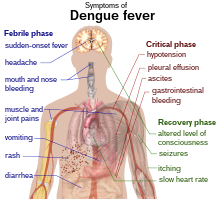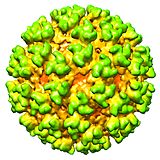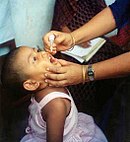The Viruses Portal
Welcome!

Viruses are small infectious agents that can replicate only inside the living cells of an organism. Viruses infect all forms of life, including animals, plants, fungi, bacteria and archaea. They are found in almost every ecosystem on Earth and are the most abundant type of biological entity, with millions of different types, although only about 6,000 viruses have been described in detail. Some viruses cause disease in humans, and others are responsible for economically important diseases of livestock and crops.
Virus particles (known as virions) consist of genetic material, which can be either DNA or RNA, wrapped in a protein coat called the capsid; some viruses also have an outer lipid envelope. The capsid can take simple helical or icosahedral forms, or more complex structures. The average virus is about 1/100 the size of the average bacterium, and most are too small to be seen directly with an optical microscope.
The origins of viruses are unclear: some may have evolved from plasmids, others from bacteria. Viruses are sometimes considered to be a life form, because they carry genetic material, reproduce and evolve through natural selection. However they lack key characteristics (such as cell structure) that are generally considered necessary to count as life. Because they possess some but not all such qualities, viruses have been described as "organisms at the edge of life".
Selected disease
Dengue fever, or breakbone fever, is an infectious tropical disease caused by the dengue virus. Symptoms include fever, headache, muscle and joint pains, and a characteristic skin rash that is similar to measles. Rarely, the disease develops into the life-threatening dengue haemorrhagic fever, resulting in bleeding, low levels of blood platelets and blood plasma leakage, or into dengue shock syndrome, where dangerously low blood pressure occurs.
Dengue is transmitted by several species of Aedes mosquito, mainly A. aegypti. First described in 1779, the incidence of dengue fever has increased dramatically since the Second World War, with around 390 million people infected each year, of whom about 40,000 die. The virus is endemic in more than 120 countries, mainly in Southeast Asia, South Asia and South America. Infection with one of the five viral types usually gives lifelong immunity to that type but only short-term immunity to the others, and subsequent infection with a different type increases the risk of severe complications. Treatment of acute dengue is supportive, using oral or intravenous fluids for mild or moderate disease; blood transfusion may be required in more severe cases. A vaccine against dengue fever is available. Reducing mosquito habitats and limiting exposure to bites are the other main methods of control.
Selected image
The castor bean tick, Ixodes ricinus, can transmit the tick-borne encephalitis virus. Ticks are common vectors for viruses, and other tick-borne diseases include Colorado tick fever and Crimean–Congo haemorrhagic fever.
Credit: Richard Bartz (24 April 2009)
In the news
26 February: In the ongoing pandemic of severe acute respiratory syndrome coronavirus 2 (SARS-CoV-2), more than 110 million confirmed cases, including 2.5 million deaths, have been documented globally since the outbreak began in December 2019. WHO
18 February: Seven asymptomatic cases of avian influenza A subtype H5N8, the first documented H5N8 cases in humans, are reported in Astrakhan Oblast, Russia, after more than 100,0000 hens died on a poultry farm in December. WHO
14 February: Seven cases of Ebola virus disease are reported in Gouécké, south-east Guinea. WHO
7 February: A case of Ebola virus disease is detected in North Kivu Province of the Democratic Republic of the Congo. WHO
4 February: An outbreak of Rift Valley fever is ongoing in Kenya, with 32 human cases, including 11 deaths, since the outbreak started in November. WHO
21 November: The US Food and Drug Administration (FDA) gives emergency-use authorisation to casirivimab/imdevimab, a combination monoclonal antibody (mAb) therapy for non-hospitalised people twelve years and over with mild-to-moderate COVID-19, after granting emergency-use authorisation to the single mAb bamlanivimab earlier in the month. FDA 1, 2
18 November: The outbreak of Ebola virus disease in Équateur Province, Democratic Republic of the Congo, which started in June, has been declared over; a total of 130 cases were recorded, with 55 deaths. UN
Selected article
Virus quantification is necessary for viral vaccine production, and is used to manage people infected with HIV, hepatitis B and C, and cytomegalovirus. A wide range of traditional and modern methods are used. Plaque assays (pictured) infect a monolayer of host cells with dilutions of the virus and count the number of holes or plaques, where cells have lysed and infected their neighbours. For viruses that do not lyse their host cell, plaques of cells showing cytopathic effects can be counted or viral proteins can be immunostained with fluorescent-labelled antibodies. These methods quantify infectious virus, while others, such as electron microscopy, return a higher concentration because they count all virus particles, whether or not they are viable. Other assays, such as the haemagglutinin assay, quantify viral proteins.
Often slow and labour intensive, traditional methods have been complemented by modern technologies that greatly reduce quantification time, including quantitative polymerase chain reaction, flow cytometry, enzyme-linked immunosorbent assays and tunable resistive pulse sensing.
Selected outbreak
The 1976 Zaire Ebola virus outbreak was one of the first two recorded outbreaks of the disease. The causative agent was identified as a novel virus, named for the region's Ebola River. The first identified case, in August, worked in the school in Yambuku, a small rural village in Mongala District, north Zaire. He had been treated for suspected malaria at the Yambuku Mission Hospital, which is now thought to have spread the virus by giving vitamin injections with inadequately sterilised needles, particularly to women attending prenatal clinics. Unsafe burial practices also spread the virus.
The outbreak was contained by quarantining local villages, sterilising medical equipment and providing protective clothing to medical personnel, and was over by early November. A total of 318 cases was recorded, of whom 280 died, an 88% case fatality rate. An earlier outbreak in June–November in Nzara, Sudan, was initially thought to be linked, but was shown to have been caused by a different species of Ebola virus.
Selected quotation
| “ | We live in a dancing matrix of viruses; they dart, rather like bees, from organism to organism, from plant to insect to mammal to me and back again, and into the sea, tugging along pieces of this genome, strings of genes from that, transplanting grafts of DNA, passing around heredity as though at a great party. | ” |
Recommended articles
Viruses & Subviral agents: bat virome • elephant endotheliotropic herpesvirus • HIV • introduction to viruses![]() • Playa de Oro virus • poliovirus • prion • rotavirus
• Playa de Oro virus • poliovirus • prion • rotavirus![]() • virus
• virus![]()
Diseases: colony collapse disorder • common cold • croup • dengue fever![]() • gastroenteritis • Guillain–Barré syndrome • hepatitis B • hepatitis C • hepatitis E • herpes simplex • HIV/AIDS • influenza
• gastroenteritis • Guillain–Barré syndrome • hepatitis B • hepatitis C • hepatitis E • herpes simplex • HIV/AIDS • influenza![]() • meningitis
• meningitis![]() • myxomatosis • polio
• myxomatosis • polio![]() • pneumonia • shingles • smallpox
• pneumonia • shingles • smallpox
Epidemiology & Interventions: 2007 Bernard Matthews H5N1 outbreak • Coalition for Epidemic Preparedness Innovations • Disease X • 2009 flu pandemic • HIV/AIDS in Malawi • polio vaccine • Spanish flu • West African Ebola virus epidemic
Virus–Host interactions: antibody • host • immune system![]() • parasitism • RNA interference
• parasitism • RNA interference![]()
Methodology: metagenomics
Social & Media: And the Band Played On • Contagion • "Flu Season" • Frank's Cock![]() • Race Against Time: Searching for Hope in AIDS-Ravaged Africa
• Race Against Time: Searching for Hope in AIDS-Ravaged Africa![]() • social history of viruses
• social history of viruses![]() • "Steve Burdick" • "The Time Is Now" • "What Lies Below"
• "Steve Burdick" • "The Time Is Now" • "What Lies Below"
People: Brownie Mary • Macfarlane Burnet![]() • Bobbi Campbell • Aniru Conteh • people with hepatitis C
• Bobbi Campbell • Aniru Conteh • people with hepatitis C![]() • HIV-positive people
• HIV-positive people![]() • Bette Korber • Henrietta Lacks • Linda Laubenstein • Barbara McClintock
• Bette Korber • Henrietta Lacks • Linda Laubenstein • Barbara McClintock![]() • poliomyelitis survivors
• poliomyelitis survivors![]() • Joseph Sonnabend • Eli Todd • Ryan White
• Joseph Sonnabend • Eli Todd • Ryan White![]()
Selected virus
Alphaviruses are a genus of RNA viruses in the Togaviridae family. The spherical enveloped virion is 70 nm in diameter, with a nucleocapsid of 40 nm. It has a single-stranded, positive-sense RNA genome of 11–12 kb. The genus contains more than thirty species, which infect humans, horses, rodents and other mammals, as well as fish, birds, other vertebrates and invertebrates. Alphaviruses are generally transmitted by insect vectors, predominantly mosquitoes, and are an example of arboviruses (arthropod-borne viruses).
The first alphavirus to be discovered was western equine encephalitis virus, by Karl Friedrich Meyer in 1930, in horses with fatal encephalitis in San Joaquin Valley, California, USA. Some members of the genus cause significant disease in humans, including the chikungunya, o'nyong'nyong, Ross River, Sindbis, Barmah Forest and Semliki Forest (pictured) viruses and the eastern, western and Venezuelan equine encephalitis viruses. Arthritis, encephalitis, rashes and fever are the most frequently observed symptoms. Large mammals such as humans usually form dead-end hosts for the viruses, although Venezuelan equine encephalitis virus is mainly amplified in the horse. No human vaccine or antiviral drug has been licensed. Prevention is predominantly by control of the insect vector.
Did you know?
- ...that the recently discovered Zamilon virophage (pictured) casts doubt on the concept of virophages?
- ...that as many as 3.3 million newborns die each year, of which 23.4% succumb to neonatal infection?
- ...that Robert Shope, described as a "walking encyclopaedia" of arboviruses, discovered more novel viruses than anyone previously?
- ...that the common banded mosquito is a vector for Murray Valley encephalitis virus, Ross River virus, and Japanese encephalitis, as well as dog heartworm and the roundworm Wuchereria bancrofti?
- ...that Zeblon Gwala, the inventor of the purported HIV/AIDS treatment ubhejane, has said he got the idea for its ingredients in a dream?
Selected biography
Many well-known people have survived the paralytic disease polio. The earliest identified case might be Siptah (pictured), Egyptian pharaoh 1197–1191 BC, whose mummified remains have a deformed leg possibly from polio. Claudius, Roman emperor 41–54 AD, walked with a limp after a childhood disease that historians have hypothesised might have been polio. Novelist Sir Walter Scott suffered paralysis in one leg after a teething fever in 1773, which left him lame; his detailed account of his disease has allowed a retrospective diagnosis of polio to be made with confidence.
For many of those who survived it, paralytic polio was a life-changing experience. The disease can lead to permanent physical disability; Itzhak Perlman, for example, plays the violin seated. Others recover completely, with some going on to excel in sports; Ray Ewry became world's foremost standing jumper after childhood polio. Some survivors, including singer Ian Dury and actress Mia Farrow, have campaigned for polio eradication or for disability rights.
In this month
6 October 2008: Nobel Prize in Physiology or Medicine awarded to Harald zur Hausen for showing that human papillomaviruses cause cervical cancer, and to Françoise Barré-Sinoussi and Luc Montagnier for discovering HIV
7 October 2005: 1918 Spanish influenza pandemic strain reconstituted
9 October 1991: Didanosine was the second drug approved for HIV/AIDS
12 October 1928: First use of an iron lung in a poliomyelitis patient
12 October 2007: Raltegravir (pictured) approved; first HIV integrase inhibitor
14 October 1977: Habiba Nur Ali was the last person to die from naturally occurring smallpox
14 October 2010: Rinderpest eradication efforts announced as stopping by the UN
16 October 1975: Last known case of naturally occurring Variola major smallpox reported
25 October 2012: Alipogene tiparvovec, a gene therapy for lipoprotein lipase deficiency using an adeno-associated virus-based vector, was the first gene therapy to be licensed
26 October 1977: Ali Maow Maalin developed smallpox rash; the last known case of naturally occurring Variola minor smallpox
26 October 1979: Smallpox eradication in the Horn of Africa formally declared by WHO, with informal declaration of global eradication
27 October 2015: Talimogene laherparepvec was the first oncolytic virus to be approved by the FDA to treat cancer
Selected intervention
Two polio vaccines are used against the paralytic disease polio. The first, developed by Jonas Salk, consists of inactivated poliovirus. Based on three wild virulent strains, inactivated using formalin, it is administered by injection and is very safe. It confers IgG-mediated immunity, which prevents poliovirus from entering the bloodstream and protects the motor neurons, eliminating the risk of bulbar polio and post-polio syndrome. The second, developed by Albert Sabin, originally consisted of three live virus strains, attenuated by growth in cell culture. Since 2016, only two strains have generally been included. They contain multiple mutations, preventing them from replicating in the nervous system. The Sabin vaccine stimulates both antibodies and cell-mediated immunity, providing longer-lasting immunity than the Salk vaccine. It can be administered orally, making it more suitable for mass vaccination campaigns. In around three cases per million doses, the live vaccine reverts to a virulent form and causes paralysis. Vaccination has reduced the number of wild-type polio cases from around 350,000 in 1988 to just 33 in 2018, and eradicated the disease from most countries.
Subcategories
Subcategories of virology:
Topics
Things to do
- Comment on what you like and dislike about this portal
- Join the Viruses WikiProject
- Tag articles on viruses and virology with the project banner by adding {{WikiProject Viruses}} to the talk page
- Assess unassessed articles against the project standards
- Create requested pages: red-linked viruses | red-linked virus genera
- Expand a virus stub into a full article, adding images, citations, references and taxoboxes, following the project guidelines
- Create a new article (or expand an old one 5-fold) and nominate it for the main page Did You Know? section
- Improve a B-class article and nominate it for Good Article
 or Featured Article
or Featured Article status
status - Suggest articles, pictures, interesting facts, events and news to be featured here on the portal
WikiProjects & Portals
 WikiProject Viruses
Related WikiProjects
WikiProject Viruses
Related WikiProjects
Medicine • Microbiology • Molecular & Cellular Biology • Veterinary Medicine
Related PortalsAssociated Wikimedia
The following Wikimedia Foundation sister projects provide more on this subject:
-
Commons
Free media repository -
Wikibooks
Free textbooks and manuals -
Wikidata
Free knowledge base -
Wikinews
Free-content news -
Wikiquote
Collection of quotations -
Wikisource
Free-content library -
Wikispecies
Directory of species -
Wikiversity
Free learning tools -
Wiktionary
Dictionary and thesaurus


















